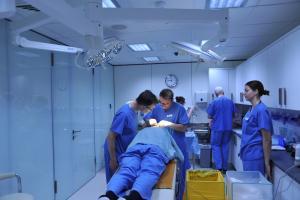Find out when hair transplant surgery or a wig is the most suitable option
This blog post deals with artificial hair solutions – the options available to hair loss patients which do not involve surgery or pharmacology. First, let’s be clear on the terminology. The traditional word for artificial hair that is placed on a person’s head is a ‘wig’. The word ‘toupee’ is often used to describe a small piece of artificial hair that is worn to cover a specific bald area, particularly by men.
In recent decades the words ‘hair piece’ have been used to mean wig, especially if the item covered a large part of the scalp. Nowadays, the words ‘hair system’ have been introduced, possibly adding a more sophisticated and bespoke connotation. Other such terminology include ‘non-surgical hair transplants’, ‘hair additions’, ‘transformation’ and a variety of less complimentary terms such as ‘rugs’ or ‘units’.
Why choose hair transplant surgery
A hair transplant is permanent, real, and often a less expensive option than wigs. The availability of top level modern hair transplant surgeries means that wigs are no longer needed for a great number of people who have suffered hair loss, be it through pattern baldness or some other process.
But that is not to say that the modern wig does not have its place in helping people who have suffered hair loss. For a small proportion of our patients, hair pieces provide the most suitable solution for their condition, either on their own or in conjunction with hair transplant surgery and/or pharmacological treatments. Sometimes a hair piece is a suitable option but there are several reasons why a hair transplant is more often a better one.
Fear of detection
Most wearers of hair systems will admit that they live in fear of a strong gust of wind, literally bumping into people, a sharp eye or long memory – anything that might betray the fact that the hair on their head is not what nature provided. They maintain a ‘no-touch zone’, an invisible border around themselves that discourages hugging or kissing on the cheek at social gatherings. They are harbouring a secret, a bald area of flesh just centimetres from other people’s eyes. The protection of this secret is emotionally draining. In contrast, a hair transplant puts real hair on that area of flesh, and it stays there for life.
Cost
There is a common misconception that a hair transplant is the most expensive solution to hair loss, and a wig is a more affordable approach. The opposite is usually the case – over time. Whereas a hair transplant can be an expensive procedure, once it’s done, it’s done. Maintenance of real hair costs little more than shampoo and a trip to the barber every couple of months.
The purchase of a wig is far cheaper than a hair transplant – at first. However, wigs have to be maintained, usually going for a ‘service’ every six weeks so there is a significant ongoing cost. When a wig is being serviced, the owner still has to go about their ordinary lives, so a second wig will be required, or a third. Those wigs too will require regular servicing and will have to be replaced as they wear out, or as their owner’s locks and hairline changes colour. Of course, wigs can be purchased cheaply but the most natural-looking ones can cost several thousand euro each.
So, what started off as a low-price wig advertised in a magazine can in reality become a set of expensive wigs with regular maintenance costs. When those costs are added up over a thirty or forty year period, it becomes clear that wigs are a far more expensive option than a hair transplant.
Another disadvantage of having a wig is the odour. Oils, wax and sebum are produced naturally by the scalp and build up under the foundation of the hair piece. If the wearer does not have a regular cleaning schedule, these products will combine to cause odour.
Baldness
Wigs can also cause baldness. A particular kind of baldness is often caused by the attachments used for keeping wigs in place. It is called traction alopecia and it is associated with the weave method which uses strands of natural hair, woven through the foundation of the wig to keep it in place. Over time, the weave pulls on the existing hair, some of which may be already weakened by the balding process. This tension on the natural hair eventually pulls it out, causing traction alopecia, a permanent baldness in that area.
When a wig is a suitable option
Undoubtedly, the modern hair system is a triumph of modern science. Using human hair or a synthetic version, the result is a head of hair that looks and feels natural. Plus, a wig can achieve better hair coverage and density than a hair transplant. It’s ‘hair’ supply is unlimited, whereas a hair surgeon can only transplant what is available in the patient’s donor area.
Temporary baldness
For people undergoing chemotherapy, childbirth, fever or some other stress that is causing temporary baldness, a hair piece is a more suitable solution that hair transplant surgery. Women, more so than men, take this option, often buying several wigs in different styles and colours.
Diffuse baldness
Sometimes the loss of hair from the person’s scalp is so great that there is insufficient donor area to make a hair transplant worthwhile. This can happen though diffuse alopecia, alopecia areata, alopecia universalis, scarring alopecia and alopecia totalis. Even extreme cases of pattern baldness can leave too much scalp to cover, with too little hair to do it with. In each case, a wig or complete baldness are the only suitable options.
Burns and other traumas
Often a patient who has suffered burns, or some other trauma, will have lost so much hair-bearing skin that they will not have enough donor hair to facilitate a worthwhile hair transplant. Sometimes, there will be enough donor hair to allow a skilled surgeon reconstruct the patient’s eyebrows, locks and hairline. This will help shape the face and make a wig look more natural.
Conclusion
The development of gold standard hair transplant surgery has made wigs mostly redundant as a solution for most cases of baldness. However, they remain the best solution for some hair-loss patients, particularly those with either temporary or extensive baldness. The quality of wigs available today along with the development of better attachment procedures allows wig-wearing people more confidence than ever before.
If you are suffering from hair loss and would like to discuss possible treatment options please contact us to request a consultation. To read more about hair loss in men visit the ISHRS website











